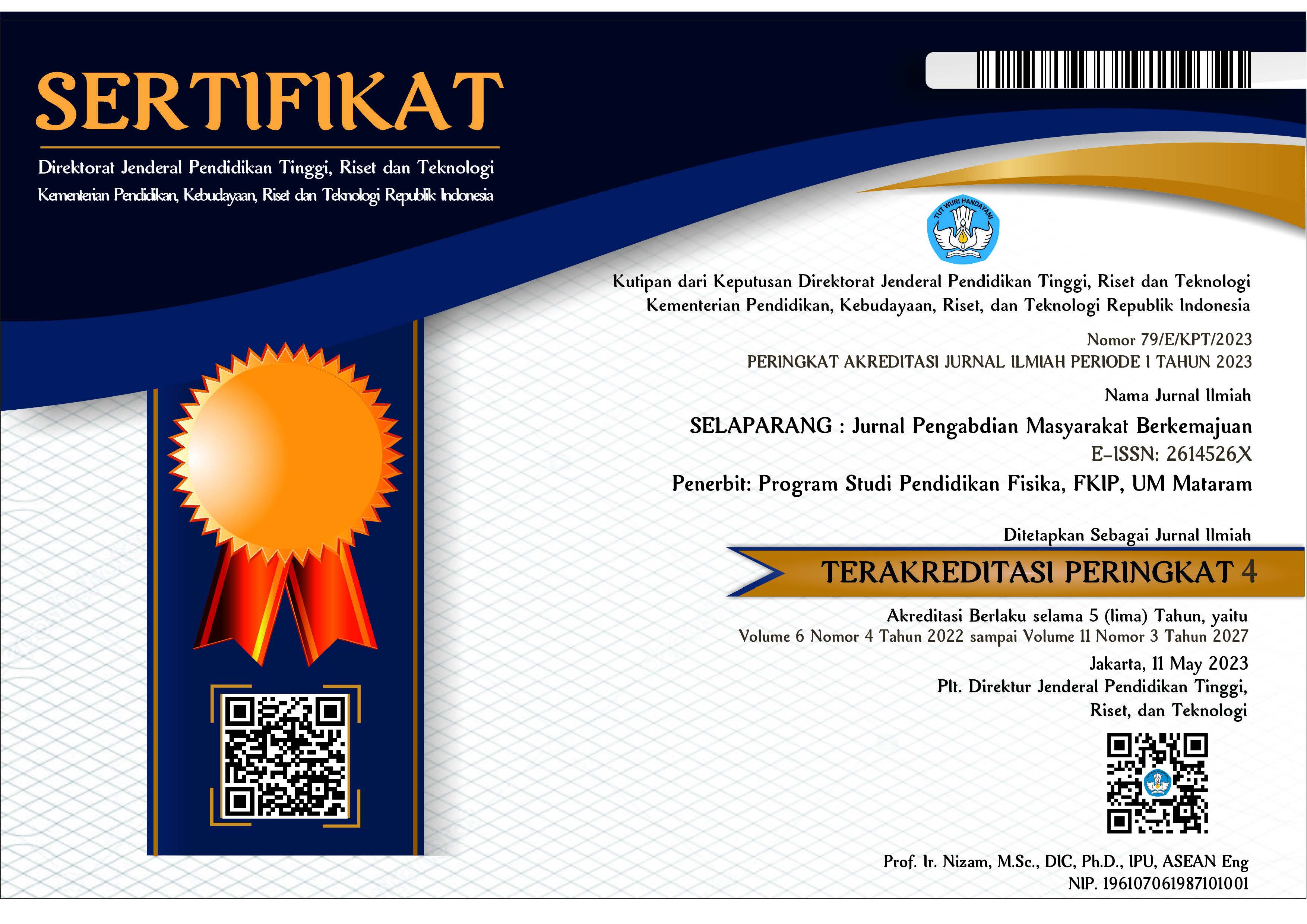PREMENSTRUAL GENTLE YOGA MELALUI MEDIA TERAPI MUSIK RELAKSASI SEBAGAI UPAYA MENGATASI GEJALA PREMENSTRUAL SYNDROM (PMS) DI DESA JEMPONG TIMUR WILAYAH KERJA PUSKESMAS KARANG PULE
Abstract
ABSTRAK
Berdasarkan analisis situasi yang teridentifikasi teradapat beberapa permasalahan yang dihadapi oleh mitra, yaitu sebagian besar remaja mengalami ketidaknyamanan menjelang menstruasi (7-10 Hari sebelum menstruasi) sebesar 80%, sebesar 25% remaja mengkonsumsi obat anti nyeri saat menstruasi dan tidak mengetahui cara penanganan selain mengkonsumsi obat anti nyeri, belum memiliki pengetahuan tentang Premenstrual Gentle Yoga dan belum mampu untuk melakukannya. Sehingga penyelesaian permasalahan yang dihadapi oleh mitra yang diberikan yaitu dengan memberikan penyuluhan Premenstrual Gentle Yoga Melalui Daring Sebagai Upaya Mengatasi Gejala Premenstrual Syndrome (PMS). Kegiatan ini diharapakan akan terus berlanjut dilakukan oleh remaja melalui Posyandu Remaja yang ada di Desa Jempong Timur. Metode kegiatan yang digunakan adalah dengan metode penyuluhan dan pelatihan. Hasil kegiatan menunjukkan bahwa terjadi peningkatan pengetahuan sebelum dan setelah kegiatan, dari 75% meningkat menjadi 85%. Potensi hasil pelaksanaan PKM-M yang telah dilaksanakan kurang lebih 1 bulan adalah remaja merasakan sekali manfaat setelah melakukan yoga, nyeri yang dirasakan agak berkurang walau belum hilang dikarenakan pelaksanaan baru dilakukan sekali dan dilakukan kembali oleh remaja dirumah masing-masing.
Kata kunci: premenstrual gentle yoga; premenstrual syndrome
ABSTRACT
Based on the analysis of the situation identified there were several problems faced by partners, namely most of the teenagers experienced discomfort before menstruation (7-10 days before menstruation) by 80%, 25% of adolescents took anti-pain medication during menstruation and did not know how to handle it besides consuming pain medication, do not have knowledge of Premenstrual Gentle Yoga and have not been able to do so. So that the solution to the problems faced by the partners given is by providing Premenstrual Gentle Yoga online as an Effort to Overcome Premenstrual Syndrome (PMS) Symptoms. It is hoped that this activity will continue to be carried out by youth through Youth Posyandu in Jempong Timur Village. The activity method used is counseling and training methods. The results showed that there was an increase in knowledge before and after the activity, from 75% to 85%. The potential results of the implementation of PKM-M that have been implemented for about 1 month are that teenagers feel once the benefits after doing yoga, the pain they feel is somewhat reduced even though they have not disappeared because the implementation has only been done once and done again by teenagers in their respective homes.
Keywords: premenstrual gentle yoga; premenstrual syndrome
Keywords
Full Text:
PDFReferences
Al-Batanony, M. A., & Al Nohair, S. F. (2014). Prevalence of Premenstrual Syndrome and Its Impact on Quality of Life among University Medical Students, Al Qassim University, KSA. Public Health Research, 4(1), 1–5.
Bertone-Johnson, E. R., Hankinson, S. E., Johnson, S. R., & Manson, J. A. E. (2008). Cigarette smoking and the development of premenstrual syndrome. American Journal of Epidemiology, 168, 938–945. https://doi.org/10.1093/aje/kwn194
Borenstein, J. E., Dean, B. B., Leifke, E., Korner, P., & Yonkers, K. A. (2007). Differences in symptom scores and health outcomes in premenstrual syndrome. Journal of Women’s Health, 16, 1139–1144. https://doi.org/10.1089/jwh.2006.0230
Cao, W., Fang, Z., Hou, G., Han, M., Xu, X., Dong, J., & Zheng, J. (2020). The psychological impact of the COVID-19 epidemic on college students in China. Psychiatry Research, 287. https://doi.org/10.1016/j.psychres.2020.112934
Chien, L. W., Chang, H. C., & Liu, C. F. (2013). Effect of yoga on serum homocysteine and nitric oxide levels in adolescent women with and without dysmenorrhea. Journal of Alternative and Complementary Medicine, 19, 20–23. https://doi.org/10.1089/acm.2011.0113
Direkvand-Moghadam, A., Sayehmiri, K., Delpisheh, A., & Satar, K.
(2014). Epidemiology of premenstrual syndrome, a systematic review and meta-analysis study. Journal of Clinical and Diagnostic Research, 8, 106–109. https://doi.org/10.7860/JCDR/2014/8024.4021
Farrokh-Eslamlou, H., Oshnouei, S., Heshmatian, B., & Akbari, E. (2015). Premenstrual syndrome and quality of life in Iranian medical students. Sexual and Reproductive Healthcare, 6, 26–27. https://doi.org/10.1016/j.srhc.2014.06.009
Heinemann, L. A. J., Minh, T. Do, Heinemann, K., Lindemann, M., & Filonenko, A. (2012). Intercountry Assessment of the Impact of Severe Premenstrual Disorders on Work and Daily Activities. Health Care for Women International, 33, 109–124. https://doi.org/10.1080/07399332.2011.610530
Masho, S. W., Adera, T., & South-Paul, J. (2005). Obesity as a risk factor for premenstrual syndrome. Journal of Psychosomatic Obstetrics and Gynecology, 26, 33–39. https://doi.org/10.1080/01443610400023049
Potter, J., Bouyer, J., Trussell, J., & Moreau, C. (2009). Premenstrual syndrome prevalence and fluctuation over time: Results from a French population-based survey. Journal of Women’s Health, 18, 33–39. https://doi.org/10.1089/jwh.2008.0932
Rakhshaee, Z. (2011). Effect of Three Yoga Poses (Cobra, Cat and Fish Poses) in Women with Primary Dysmenorrhea: A Randomized Clinical Trial. Journal of Pediatric and Adolescent Gynecology, 24, 192–196. https://doi.org/10.1016/j.jpag.2011.01.059
Rani, M., Singh, U., Agrawal, G. G., Natu, S. M., Kala, S., Ghildiyal, A., & Srivastava, N. (2013). Impact of yoga nidra on menstrual abnormalities in females of reproductive age. Journal of Alternative and Complementary Medicine, 9, 925–299. https://doi.org/10.1089/acm.2010.0676
Rapkin, A. J., & Winer, S. A. (2009). Premenstrual syndrome and premenstrual dysphoric disorder: Quality of life and burden of illness. Expert Review of Pharmacoeconomics and Outcomes Research, 9, 157–170. https://doi.org/10.1586/erp.09.14
Reed, S. C., Levin, F. R., & Evans, S. M. (2008). Changes in mood, cognitive performance and appetite in the late luteal and follicular phases of the menstrual cycle in women with and without PMDD (premenstrual dysphoric disorder). Hormones and Behavior, 54, 185–193. https://doi.org/10.1016/j.yhbeh.2008.02.018
Sakuma, Y., Sasaki-Otomaru, A., Ishida, S., Kanoya, Y., Arakawa, C., Mochizuki, Y., Seiishi, Y., & Sato, C. (2012). Effect of a home-based simple yoga program in child-care workers: A randomized controlled trial. Journal of Alternative and Complementary Medicine, 18, 769–776. https://doi.org/10.1089/acm.2011.0080
Tschudin, S., Bertea, P. C., & Zemp, E. (2010). Prevalence and predictors of premenstrual syndrome and premenstrual dysphoric disorder in a population-based sample. Archives of Women’s Mental Health, 13, 485–494. https://doi.org/10.1007/s00737-010-0165-3
Wang, Chen, Horby, P. W., Hayden, F. G., & Gao, G. F. (2020). A novel coronavirus outbreak of global health concern. In The Lancet. https://doi.org/10.1016/S0140-6736(20)30185-9
Wang, Cuiyan, Pan, R., Wan, X., Tan, Y., Xu, L., Ho, C. S., & Ho, R. C. (2020). Immediate psychological responses and associated factors during the initial stage of the 2019 coronavirus disease (COVID-19) epidemic among the general population in China. International Journal of Environmental Research and Public Health, 17, 1729. https://doi.org/10.3390/ijerph17051729
DOI: https://doi.org/10.31764/jpmb.v4i1.3284
Refbacks
- There are currently no refbacks.

This work is licensed under a Creative Commons Attribution-ShareAlike 4.0 International License.
______________________________________________________
Jurnal Selaparang
p-ISSN 2614-5251 || e-ISSN 2614-526X
EDITORIAL OFFICE:



















